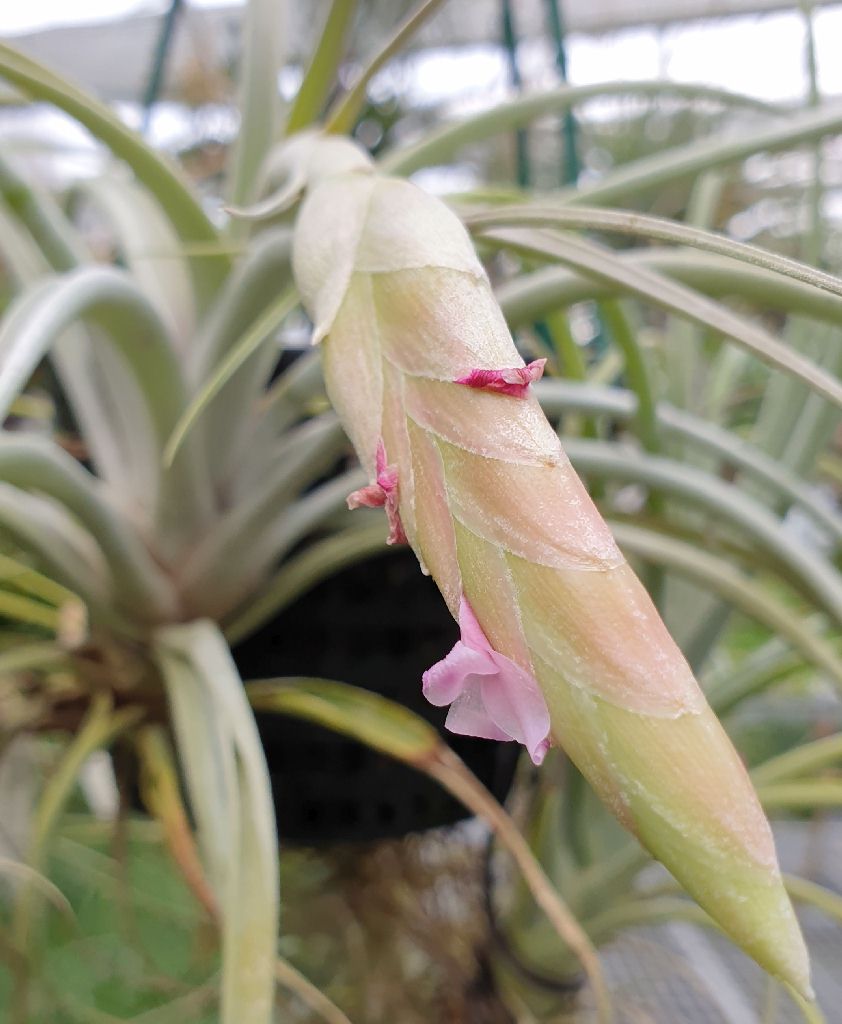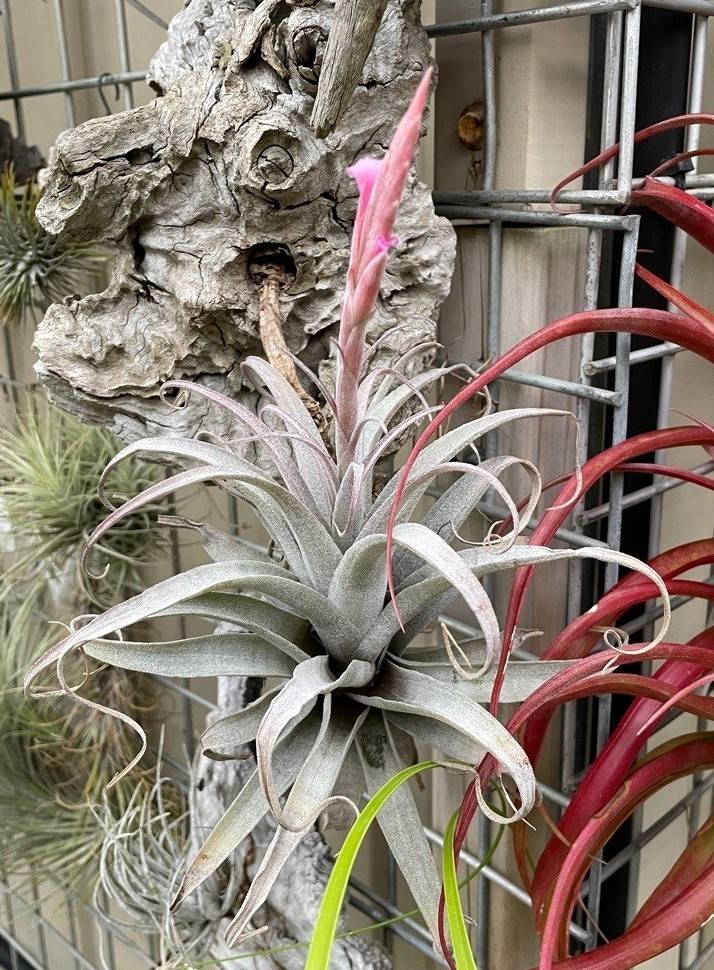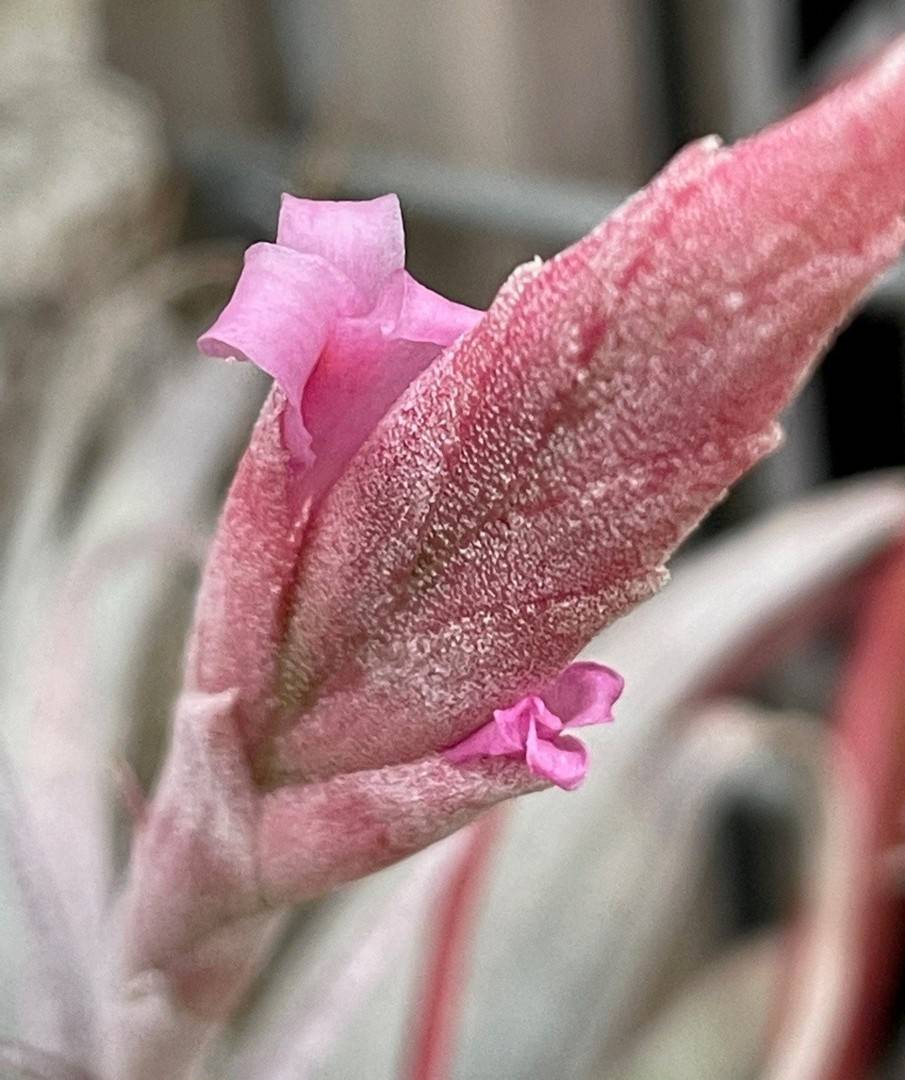


PLANT - Short stemmed, leaves numerous, spirally arranged.
LEAF SHEATH - Not clearly evident, 1cm high, 2-2.2cm wide, pale brown.
LEAF BLADE - Thin triangular, long attenuate, spreading wide to reflexed, to 18cm long, 2cm wide, channelled, dense grey scaled.
FLOWER STEM - Exceeds the leaves or shorter, erect to weakly bent, to 15cm long, 0.5cm thick, green, lepidote, densely enclosed by leaflike scape bracts.
SCAPE BRACTS - The top ones with longer, more adjacent, sheaths and shorter to 3cm long, filiform, reddish brown, dense lepidote blade.
INFLORESCENCE- Bent over, simple or bipinnate. Apart from the central spike there are a further two short, to 5cm long, short stemmed side spikes.
PRIMARY BRACTS - Broad-oval, acuminate, to 3.5cm long, 2cm wide, reddish brown, dense white scaled.
CENTRAL SPIKE - To 8cm long, 2cm wide, complanate, to 15 flowered.
RHACHIS - Visible, edges flat, but not hollowed, green lepidote.
FLORAL BRACT - Imbricate, at the base flat two keeled, the upper half not keeled, scarcely sharp, the hooked tip indistinctly keeled, 3cm long, 1cm wide, pale carmine reddish, at the bottom green, robust, underneath persistently dense lepidote, (not becoming glabrous), exceeds the sepal.
FLOWER- Erect, to 3.5cm long, sessile, adjacent to the rhachis, weakly scented.
SEPAL- 2-2.2cm long, the posterior sharply keeled and joined for 5mm, acuminate, the top half pale carmine-red, at the bottom green, lepidote, (scales white with brown centre).
PETAL- Thin tongue like, acuminate, 3.5cm long, 4mm wide, edges wavy with reflexed tip, light carmine-red, at the bottom green.
STAMENS & STYLE - Enclosed. Filament white, strongly pleated. Anther thin, 4mm long, yellow, style and lobes as long as the anthers.
HOLOTYPE Rauh 53 774 (19. 7. 1980) HEID
HABITAT - Laguna Saurococha, Cajamarca, PERU on rocks, 2700m.
DIFFERS FROM T. MACBRIDEANA IN THAT
1. - Plant short not long caulescent.
2. - Leaf to 18cm long, spreading or recurved, channelled.
3. - Flower stem distinct, but shorter than the leaves.
4. - Inflorescence bipinnate with 1-2 spreading spikes, rhachis visible.
5. - Filament plicate not straight.
Tillandsia pseudomicans W Rauh Sp. nova Trop Subtrop Pflanz. 12: 21-27. 1974
Planta breviter caulescens, florifera ad 20 cm alta. Folia 10-12, erecta, apicibus arcuato-reclinatis. Vagina inconspicua, 4-5 cm longa, 2,5-3 cm lata, brunneo-lepidota. Lamina 10 15 cm longa, supra vaginam 2 cm lata, involuta, appresso-denso-cano-lepidota, anguste triangulata, apice subulato. Scapus inflorescentiae 8-10 cm longus, arcuato-patens, 5 mm diametiens, laxe lepidotus. Folia scapi imbricata, longiora quam internodia, scapum omnino involventia, foliis similia, laminis longis cano-lepidotis. Inflorescentia simplex, complanata, 3-5 (-10) flora, 4-5 (-10) cm longa, usque ad 2 crn lata. Bracteae florales imbricatae, distichae, 2,5-3 cm longae, rhachidem excavatum obtengentes ecarinatae, coriaceae, rubescenti-brunneae, cano-lepidotae, sepala superantes. Sepala 1,5- 1,8 cm longa, viridia, posteriora carinata ad 2 mm connate, apicibus acuminate, fere glabra. Petala rubra, 2,5 cm longa, 4 mm lata, lingulata, apicibus patentibus. Stamina et Stylus inclusa.
Habitat: Peruvia, in valle Apurimac inter Andahuaylas et Abancay (Dptm. Apurimac), 2200 m. s.m.
Holotypus: Rauh, Nr. 25945 (Sept. 1970) in herbario inst. bot. system. heidelbergensis (HEID).
T. pseudomicans a T. micans L. B. Smith differt caule minore, bracteis floralibus
cano-lepidotis, margine non membranaceis et petalis brevioribus angustioribus rubris.
Translated from German by Derek Butcher
Plant short caulescent, flowering to 20cm high, leaves 10 – 12, erect, apiculate, curved and bent downwards.
Leaf Sheath indistinct, 4 – 5cm long, 2.5 to 3cm wide, brown lepidote.
Leaf Blade 10 – 15 cm long, 2cm wide next to sheath, rolled inwards, appressed dense grey scaled, narrow triangular, subulate tip.
Scape 8 – 10 cm long, bent-spreading, 5mm diam. laxly lepidote.
Scape Bracts imbricate, longer than the internodes, enveloping the whole stem, similar to the leaves, long blade, grey lepidote
Inflorescence Simple, complanate, 3 – 5 (-10) flowered, 4 – 5 (-10) cm long, to 2cm wide.
Floral bracts imbricate, distichous, 2.5 to 3cm long, covering over the pitted rhachis, not keeled, leathery, reddish-brown, grey lepidote, exceed the sepals.
Sepals 1.5 to 1.8 cm long, green, posterior ones carinate and joined for 2mm, acuminate, tipped, almost glabrous.
Petals red, 2.5cm long, 4mm wide, tongue-shaped, tips spreading.
Stamen & Style included.
Holotype Rauh Nr. 25945 (Sept. 1970) HEID
Habitat Apurimac valley between Andahuaylas and Abancay (Dept. Apurimac) Peru 2200m
Differs from T. micans by
1. Plant stem smaller
2. Floral bracts grey lepidote
3. Floral bract edges not membranous
4. Petals shorter, more narrow and red not white.